Candlestick patterns are a fundamental part of technical analysis, giving traders valuable insights into market sentiment and potential price direction. Among these patterns, the spinning top candlestick stands out as a simple yet powerful signal of indecision in the market.
A spinning top is identified by its small real body combined with long upper and lower shadows. This shape reflects a battle between buyers and sellers where neither side is able to take clear control, leaving the price close to where it opened. While on its own it does not predict a strong reversal or continuation, it often acts as an early warning sign of a potential change or pause in the market trend.
Understanding spinning tops and how to apply them in trading can help traders recognize periods of uncertainty and prepare for the next decisive market move.
What is a Spinning Top Candlestick?
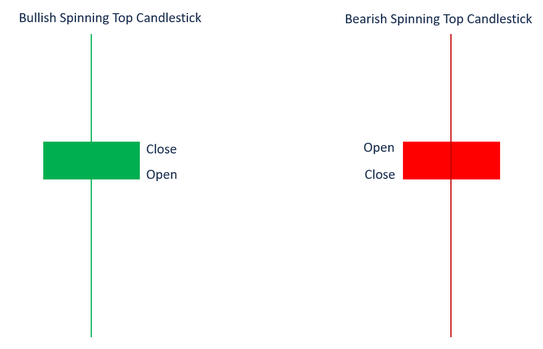
A spinning top candlestick is a pattern that appears on price charts with a small real body and long upper and lower shadows. The small body means that the opening and closing prices are close to each other, while the long shadows show that the market moved significantly in both directions during the session.
This structure reflects a lack of clear control between buyers and sellers. Neither side manages to dominate the price action, and the result is a candle that signals uncertainty and hesitation. In many cases, spinning tops appear after strong moves, showing that momentum may be slowing down and the market could be preparing for a change.
Although a single spinning top is not enough to predict the next move with certainty, its presence is an important clue that the balance of power between buyers and sellers is shifting.
Bullish and Bearish Context of Spinning Tops
The spinning top candlestick does not carry the same meaning in every situation. Its interpretation depends greatly on the direction of the current market trend and the location of the candle on the chart.
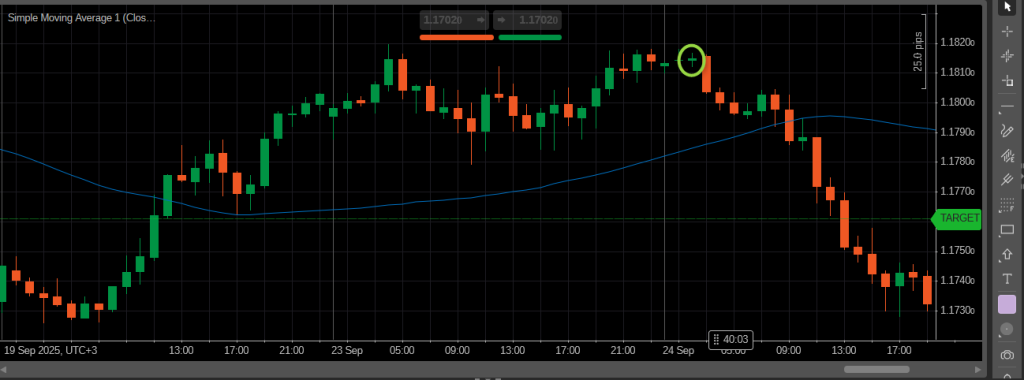
In an uptrend, a spinning top often signals that buyers may be losing momentum. The long wicks indicate that the market attempted to push higher, but sellers quickly countered the move, preventing a strong close. This situation can mark the beginning of a reversal or at least a period of sideways consolidation. Traders watching an extended bullish rally may view the spinning top as a sign to lock in profits or prepare for a potential shift.
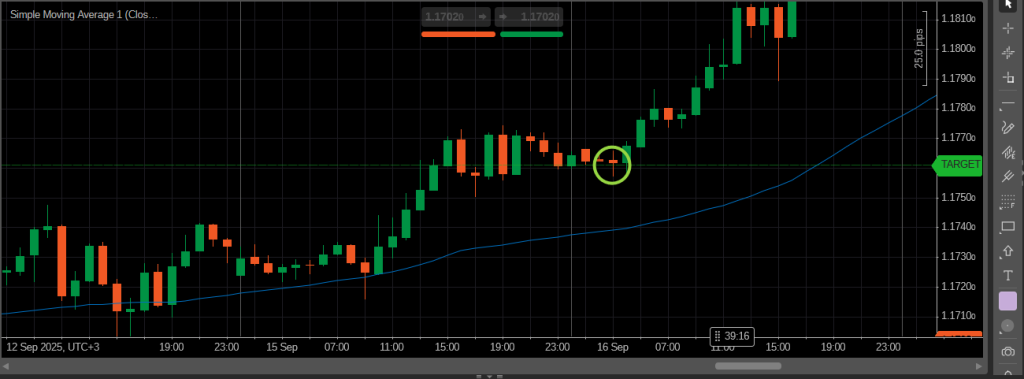
In a downtrend, the spinning top suggests that selling pressure could be weakening. Sellers may still push the price lower during the session, but buyers step in with equal strength, leaving the market undecided. If this occurs near a strong support zone, it can be an early signal of a reversal to the upside. For example, in cryptocurrency trading, a spinning top after a steep decline in Bitcoin often alerts traders that buyers are beginning to return.
It is also important to note that spinning tops are not strong signals on their own. A single candle showing indecision does not guarantee a reversal. Traders must always consider the broader context, such as overall trend direction, support and resistance levels, and confirmation from the next candlestick. Only by combining these elements can the spinning top be used effectively as part of a trading strategy.
How to Trade Using Spinning Tops
Trading with spinning tops requires patience and confirmation. Since these candlesticks only signal indecision, they should never be used in isolation. Instead, traders combine them with context and other technical tools to increase reliability.
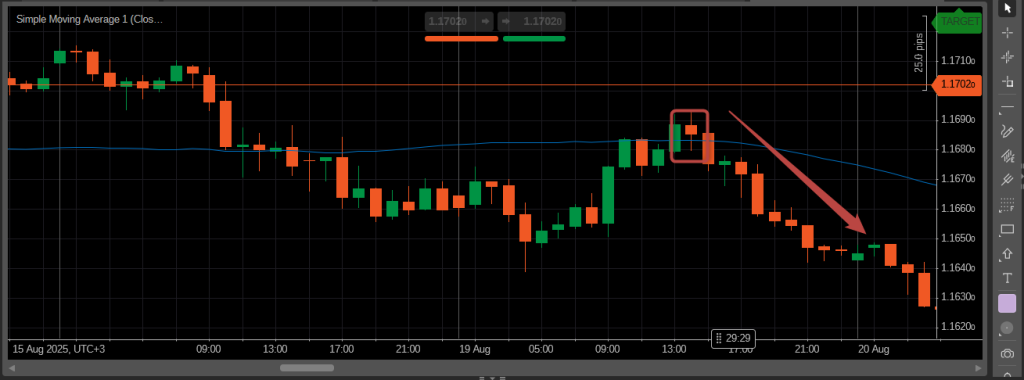
When a spinning top forms during an uptrend, many traders wait for the next candle to confirm the direction. If the following candle closes lower and breaks a nearby support zone, it strengthens the case for a bearish reversal. On the other hand, if the next candle closes higher, the spinning top may simply represent a pause before the uptrend continues.
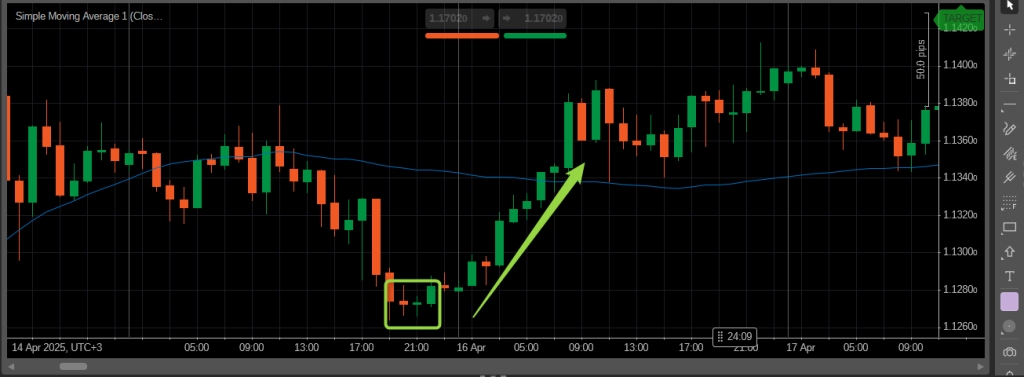
In a downtrend, a spinning top near a strong support area may indicate that sellers are losing momentum. Traders often wait for a bullish confirmation candle, such as a strong green candle closing above the spinning top’s high, before entering long positions. This combination of indecision and confirmation helps filter out false signals.
Using spinning tops alongside indicators can also improve results. For example, if an RSI shows oversold conditions when a spinning top appears at support, the chance of a bullish reversal becomes stronger. Similarly, in an uptrend, if a spinning top forms at resistance while RSI shows overbought conditions, the possibility of a bearish reversal is higher.
Volume can also act as a confirming factor. A spinning top with unusually high trading volume suggests a stronger battle between buyers and sellers, making the outcome of the following candle even more significant.
By combining spinning tops with confirmation candles, support and resistance zones, and technical indicators, traders can build a structured approach that turns this neutral candlestick into a valuable signal within their trading strategy.
Advantages of Trading with Spinning Tops
One of the biggest advantages of spinning tops is their versatility. They can appear in any market and on any timeframe, making them useful for both day traders and swing traders. Because they signal indecision, spinning tops often serve as an early warning system before major price moves. Traders who spot them in the right context gain valuable insight into potential reversals or trend continuation.
Another benefit is their simplicity. Spinning tops are easy to recognize on the chart, even for beginners. Unlike complex technical patterns, this candlestick relies on clear visual cues: small bodies with long shadows. This straightforward identification makes them a practical tool for traders who prefer clean and simple chart analysis.
Spinning tops also work well when combined with other elements of technical analysis. They can help traders confirm signals given by indicators such as RSI, MACD, or moving averages. For example, if RSI is showing divergence and a spinning top appears at a resistance zone, the case for a trend reversal becomes stronger.
Finally, spinning tops provide flexibility because they do not dictate a fixed outcome. Instead of forcing traders into one direction, they invite traders to wait for confirmation and adapt. This patience-oriented approach helps avoid rushed decisions and encourages discipline, which is essential for long-term trading success.
Disadvantages of Relying on Spinning Tops
While spinning tops can be valuable, they also come with limitations. The most important drawback is that they do not provide clear direction on their own. A spinning top simply shows indecision, which means the price could move up, down, or continue sideways. Traders who act too quickly without confirmation risk entering false trades.
Another disadvantage is the frequency of their appearance. Spinning tops occur often in volatile markets, such as cryptocurrencies or forex, but not all of them carry real significance. Without additional context like support and resistance levels, volume, or trend direction, many spinning tops can lead to noise rather than actionable signals.
Practical Tips for Using Spinning Tops in Trading
To make the most out of spinning tops, traders should always place them within the bigger market picture. Context is everything. A spinning top at a random place in the chart carries little meaning, but when it appears near a strong support or resistance zone, its significance grows. Always connect the candlestick to key levels before deciding on a trade.
Confirmation is another critical element. Never trade a spinning top in isolation. Wait for the next candle to confirm the direction. A strong bullish candle after a spinning top near support strengthens the case for buying, while a bearish candle following one at resistance signals selling pressure. This step reduces the risk of false signals.
Pairing spinning tops with technical indicators can improve decision-making. Indicators like RSI, MACD, or moving averages provide additional context and increase the probability of success. For example, if a spinning top forms while RSI exits oversold territory, the likelihood of a reversal increases.
Risk management should always be part of the plan. Since spinning tops only show indecision, setting stop-loss levels is essential to protect against sudden market moves. Position sizing should also reflect the uncertainty that this candlestick represents.
Lastly, practice is key. Studying past charts and identifying spinning tops in different conditions will help traders understand when they carry more weight. Backtesting strategies that include spinning tops builds confidence and sharpens the ability to filter useful signals from noise.
They are also less effective in strong trending markets. In powerful bullish or bearish trends, a spinning top may only represent a brief pause before the trend resumes. Traders relying solely on this candlestick risk mistaking a continuation signal for a potential reversal, which can lead to losses.
Finally, spinning tops require patience and discipline. Beginners may find it difficult to wait for confirmation and might act impulsively, which reduces the reliability of this candlestick as part of their strategy.
Conclusion
Spinning tops may look like simple candlesticks, but they carry important information about market psychology. By showing indecision between buyers and sellers, they serve as an early signal that momentum could shift. On their own, spinning tops do not guarantee reversals or continuation, but when placed in the right context—near support and resistance, alongside confirmation candles, and with the help of technical indicators—they become a reliable part of a trader’s toolkit.
For traders, the real power of spinning tops lies in patience and discipline. They remind us that the market often pauses before making its next move, and that waiting for confirmation is just as important as spotting the signal itself. Whether used in forex, crypto, or stock trading, spinning tops provide flexibility, simplicity, and an added layer of insight into market dynamics.
By combining candlestick knowledge with sound risk management and consistent practice, traders can transform spinning tops from a sign of uncertainty into a strategic advantage.




